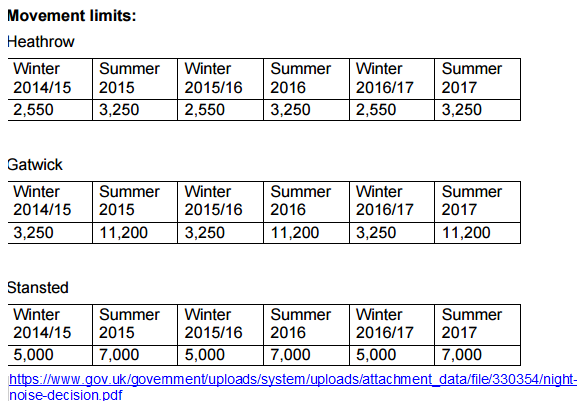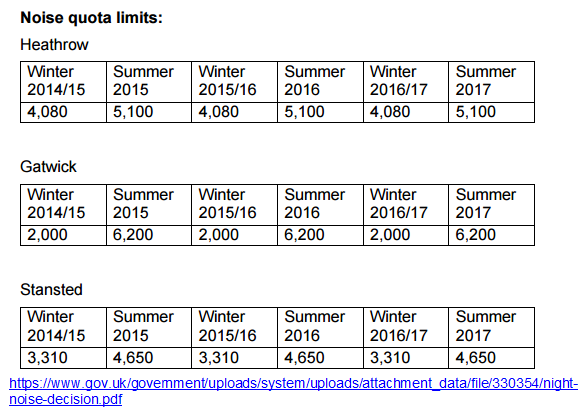Night flights at Gatwick
Gatwick: The number of flights allowed at Gatwick between 11.30 pm and 6.00 am is limited by a quota – at present 11,200 in the summer (seven months) and 3,250 in winter. That is a total of 14,450 flights per year.
Stansted: By contrast, Stansted currently has permission to operate 12,000 night flights per year, between 11.30pm – 6am, more than twice as many as are permitted at Heathrow.
Heathrow: Heathrow is restricted to 5,800 night take-offs & landings per year between 11.30pm- 6am.
The numbers of flights at night at the three “designated” airports (Heathrow, Gatwick and Stansted) are controlled by the Night Flying restrictions, from the DfT. The document is NIGHT FLYING RESTRICTIONS AT HEATHROW, GATWICK AND STANSTED
Two tables from the DfT document (Page 8) are copied below:


The Government has announced that there will be no changes to the present system, no changes to the permitted number of night flights, and no changes to the noise quotas until 2017. Local campaign, GACC (Gatwick Area Conservation Campaign) is appalled at this ‘cop-out’. Since the present noise “quotas” are not fully used, it is permitting a substantial worsening of the disturbance at night around Gatwick.
See GACC response.
A detailed Stage 1 consultation about the system for controlling night flights at the major airports ended in April 2013. GACC submitted a detailed response .
Gatwick has more night flights than any other airport in the UK except East Midlands. GACC said, in its response to the DfT consultation on night flights (November 2013) that: “The very least that could have been proposed in this consultation would have been to reduce the size of the night flight quota to match the actual use. Not to reduce the movements quota is for the Department knowingly to connive in the possibility of a substantial increase in the number of night flights. That would be contrary to the policy set out in the Aviation Policy Framework White Paper: ‘to limit, and where possible, reduce the number of people significantly affected by aircraft noise.’ “
NIGHT FLIGHT RULES
The noisiest types of aircraft are banned between 11.00 pm and 7.00 am. The number of flights between 11.30 pm and 6.00 am is limited by a quota – at present 11,200 in the summer (seven months) and 3,250 in winter.
At night, between 2330 and 0600, the noise limit is 87 dBA.
There is also a separate quota system based on noise, with noisy aircraft using more points. Aircraft are classified as QC1, QC2, QC4 etc. A QC4 aircraft uses four points and makes twice as much noise as a QC2. A QC2 uses two points and makes twice as much noise as a QC1. There has been a change in classification which makes it difficult to compare past and future figures.
The number of flights between 11.30 pm and 6.00 am is limited by a quota – at present 11,200 in the summer (seven months) and 3,250 in winter. In summer 2006 the actual number was 10,939 (average 50 a night), and in winter 2006/07 2,734.
In 2006 the government announced its decision on the number of night flights from Gatwick for the six years 2007 – 2012. The number of night flights remains at roughly the previous level but there is to be a gradual 10% reduction in the amount of noise permitted at night. The noisiest aircraft were banned (except when delayed). GACC has welcomed this small improvement. GACC press release
Gatwick will still have more night flights than Stansted, and twice as many as Heathrow. The total level of noise permitted at night each year at Gatwick will be greater than at Stansted but less than at Heathrow.
Aircraft of QC16 and QC8 cannot be scheduled to operate between 11pm and 7am.
Night flights – small improvement welcomed
Under the new rules for the next six years announced today, despite strong pressure from BAA and the Gatwick airlines, there will be no more night flights at Gatwick than at present.
But Gatwick will still have twice as many as Heathrow.
GACC is pleased that the noise quotas are to be gradually reduced, to bring about roughly a 10% reduction in the level of noise at night over the next six years.
It is also good news that the government is getting rid of the ‘headroom’ in the quotas which could have allowed a large increase in the number and noise of night flights.
Chairman of GACC, Brendon Sewill, said “The Government has listened to what we have said, and we welcome these improvements.”
We also welcome the decision to ban regular night flights by the noisiest types of aircraft (classified as QC4) but it is disappointing that such flights will still be permitted when a flight is delayed. When the airline is inefficient, the public get woken up.
The announcement today is disappointing in that the numbers of night flights and the noise
levels will be higher than originally proposed in the consultation last year. The Government has not lived up to its good intentions.
The new limits on night flights will, of course, apply to BAA under its new foreign
ownership. There will be no opportunity to recoup the cost of buying BAA by increasing night flights.
Some people learn to sleep despite being under the flight path but for others night flights
cause great disturbance, lack of sleep and anxiety. It is a disgrace that at night the airlines can schedule cheap passenger and cargo flights, paying no fuel tax and no VAT, and no compensation to the people who suffer.
Restrictions on UK ‘night flights’ at Heathrow, Gatwick and Stansted extended until 2017
17.7.2014
and
Government to make no significant change to night flights regime at Heathrow, Gatwick and Stansted until Airports Commission report
11.11.2013
In January 2013 the DfT put out the first part of its consultation on the night flight regime at the UK’s 3 designated airports, Heathrow, Gatwick and Stansted. The DfT said then that the 2nd consultation would be published later in 2013, to include specific proposals for the new regime, such as the number of permitted night flights – informed by the evidence from the first consultation. The DfT then published (November 2013) a 2nd stage, but instead of any specific measures, it proposed no significant change to the night flight regime at Heathrow until 2017. It says it does not want to pre-empt the findings of the Airports Commission (which finally published its report on 1.7.2015).
That effectively passed the buck to Sir Howard Davies. The current night flight regime for the 3 airports was due to end in October 2014 but was then extended again to 2017.
Normally a new regime is put in place to cover the next 5 – 6 years. This time the Government has decided in effect to roll-over the existing regime until 2017. The only change for Heathrow is a proposal “to extend the operational ban on the noisiest types of aircraft to include an extra half hour, the 23.00-23.30 period.
